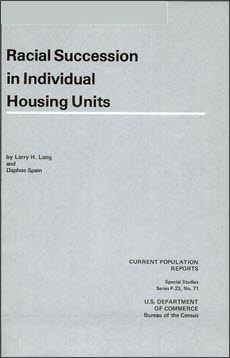Racial Succession in Individual Housing Units
Racial Succession in Individual Housing Units
Presents an analytical study on the subject of racial succession in individual housing units as a result of the high rate of residential mobility in the United States.
The third in a series of analytical studies undertaken by demographers in the Population Division of the Bureau of the Census, these occasional papers include a speculative analysis and illustrative hypotheses by authors as an aid in understanding the statistics and assessing their potential impact on public policy.
This study provides the first opportunity to measure, on a nationwide basis, the proportion of annual housing turnover that represented racial succession. The data came from matching overlapping panels of Current Population Surveys conducted from March 1967 through 1971 by the Census Bureau. Topics examined include racial succession and probabilities of racial succession in housing units of cities, suburbs, and regions; and selected characteristics of households vacating a housing unit and the households that replace them.
A Note on Language
Census statistics date back to 1790 and reflect the growth and change of the United States. Past census reports contain some terms that today’s readers may consider obsolete and inappropriate. As part of our goal to be open and transparent with the public, we are improving access to all Census Bureau original publications and statistics, which serve as a guide to the nation's history.
Others in Series
Publication
Publication
Publication




